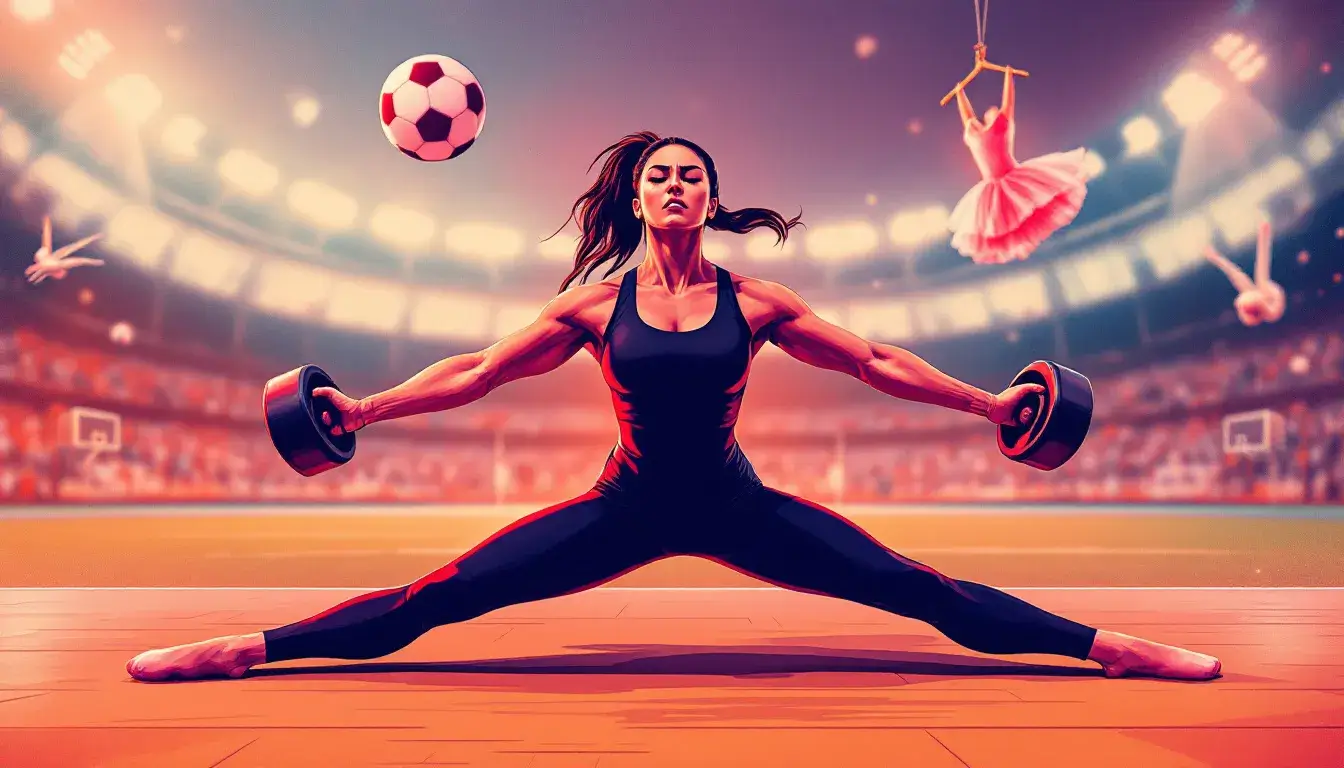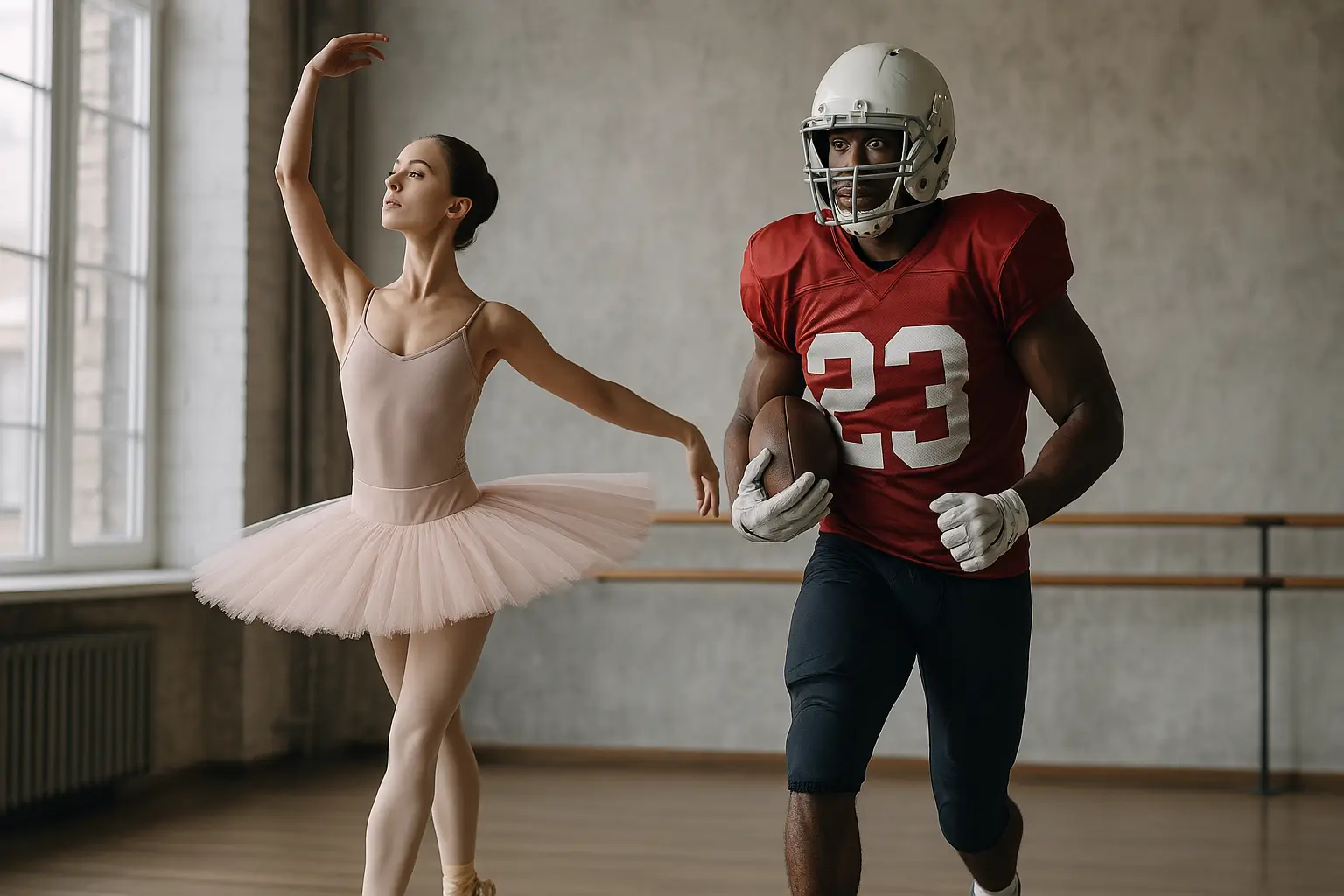Is ballet harder than football? This is an important point we’ll compare regarding the physical demands, skills, and mental challenges. We’ll compare the physical demands, skills, and mental challenges.
Graceful Insights
- Ballet training demands exceptional endurance and core strength, often exceeding traditional athletic standards, while football emphasizes explosive power and physical contact.
- Both disciplines require intense mental focus and dedication, with ballet dancers facing unique performance pressures that highlight the artistry of their craft compared to the tactical nature of football.
- Cultural perceptions differ greatly, with ballet viewed as an elite art form and football celebrated as a mainstream sport, influencing career opportunities and athlete recognition in both fields.
Art de Podcast
| Aspect | Ballet | Football |
|---|---|---|
| Physical Demands | Requires significant strength, flexibility, and control. Dancers often train extensively to perform complex movements precisely. | Emphasizes strength, speed, and agility. Players undergo rigorous training to develop explosive power and endurance. |
| Injury Risk | High risk of musculoskeletal injuries, including stress fractures and tendinitis. Studies show dancers experience pain impairing performance approximately 29% of the time. | Susceptible to acute injuries like concussions, ligament tears, and fractures due to high-impact collisions. |
| Career Longevity | Often retire by their early 40s due to physical demands. Some countries propose pensions recognizing the burdensome nature of the profession. | Careers can extend into the mid to late 30s, though injuries can shorten playing time. |
| Training Intensity | Professional dancers may train up to 10 hours daily, focusing on technique, strength, and endurance. | Players engage in daily practices, including drills, strength training, and strategic planning. |
| Skill Complexity | Requires mastery of precise, choreographed movements performed gracefully under pressure. | Involves complex plays requiring coordination, quick decision-making, and teamwork. |
Physical Demands of Ballet and Football

Both ballet and football require remarkable physical exertion, each demanding unique endurance and strength capabilities from their participants. Ballet dancers perform for hours, showcasing high cardiovascular fitness and muscular endurance. The act of dancing combines strength, balance, and endurance while maintaining a graceful appearance, making it a physical challenge and an art form that requires emotional expression and precision. This mix of endurance and control often exceeds what is seen in many traditional athletes, raising questions about the overall level of athleticism in various sports.
Ballet dancers are often seen as having more balanced athleticism due to their art’s diverse physical demands. Their unique combination of strength and endurance usually puts them ahead of football players in overall athleticism, especially in the dance world.
However, football players also exhibit impressive physical prowess, engaging in rigorous and physically demanding training regimes to maintain the stamina needed for matches and compete as competitors in other sports.
Endurance and Stamina
To excel, ballet dancers and football players must have exceptional endurance and stamina. Ballet dancers typically undergo extensive daily training sessions that can last several hours, emphasizing the need for extraordinary stamina during performances. These rehearsal periods often exceed 20 hours a week, contrasting with football players who practice between 15 to 20 hours weekly.
While football players also engage in rigorous training regimes involving practice and gameplay, the sustained physical effort required in ballet is unparalleled. Both disciplines demand extraordinary endurance levels to perform optimally during extended rehearsals and matches. According to the data, researchers ranked dance as the most physically demanding job, scoring 97 out of 100, even above traditional athletes, underscoring the intense physicality and endurance required in the field.
Strength and Core Muscles
Core strength in ballet is crucial for complex movements and balance. Pirouettes and jumps rely on strong core engagement to stabilize the body. Jumps and lifts in ballet demand significant strength, highlighting dancers’ powerful legs and core muscles.
Football players depend on lower body strength for explosive movements like sprinting and jumping, requiring well-developed one-leg and hip muscles. Both ballet and football require immense strength and core stability to succeed. A recent chart scoring assessment ranks dancers as having a higher level of physicality, scoring 97 out of 100, compared to athletes from other sports who score lower on the same chart.
Pain and Injury
Injuries are common in ballet and football, though they differ significantly. Ballet dancers often suffer from overuse injuries, particularly affecting the feet, ankles, and knees due to repetitive high-impact movements. Chronic issues, usually accompanied by pain, are prevalent among professional ballet dancers, especially related to their feet, ankles, and lower back.
Football players frequently endure injuries from physical contact, like sprains and fractures, as well as muscle strains from intense physical activity. Concussions, knee injuries, and ankle sprains are common in football, emphasizing the sport’s physical demands.
Skill and Technique

Both ballet and football require high skill and technique to execute complex movements precisely. Ballet, as a difficult sport, emphasizes precise movements and artistry, demanding years of rigorous training to master. Though requiring technical expertise, football focuses on tactical execution and quick decision-making.
Mastery in both disciplines through rigorous training underscores the exceptional skill and technique needed for success in ballet and football. The dedication to perfecting these skills is a testament to the athletes’ commitment and passion for their respective arts.
Choreography vs. Plays
Ballet choreography demands precise timing and fluidity, paralleling the strategic execution of football plays. Unlike a basketball game, where players must make real-time decisions on the court, ballet performances require sustained focus on technique and artistry, demanding exceptional endurance from dancers.
Football plays are strategically designed to adapt to dynamic situations, requiring quick decision-making and constant situational awareness. The meticulous design of ballet choreography contrasts with football’s strategic formations, highlighting unique challenges in each discipline.
Balance and Coordination
Ballet dancers depend heavily on core stability and balance for intricate routines. Finely tuned balance and coordination in ballet are critical for executing complex sequences without losing form. This level of bodily awareness and stability is cultivated through years of dedicated practice.
Football players also require excellent balance to navigate the field effectively. Stability and agility are essential for football players to perform high-speed maneuvers and avoid defenders.
Mistakes and Precision
Both ballet dancers and football players face significant pressure during performances or games, potentially leading to performance anxiety. The pressure to perform flawlessly in ballet can cause higher performance anxiety than football players.
Performing in front of an audience generates significant psychological stress for ballet dancers, akin to the anxiety football players face during high-stakes matches. The precision required in both disciplines means mistakes can be costly, affecting overall performance and outcome.
Mental Challenges

Balancing and football involve immense mental challenges, requiring self-control, focus, and discipline. In ballet, athletic demands encompass physical strength and a high degree of mental focus and precision. The mental discipline required to execute complex movements with artistry is a significant aspect of ballet.
Football also demands similar discipline, requiring players to remain concentrated under pressure throughout games. Mental challenges in both disciplines highlight the importance of focus and self-control for peak performance.
Focus and Concentration
Ballet requires unwavering focus and concentration to execute intricate movements, often more than a football match’s dynamic, fast-paced nature. The focus required in ballet is usually greater than in football, as dancers perform complex routines with precision, often for more than two minutes at a time.
Achieving ballet requires intense focus and maintaining precision and artistry, akin to the concentration needed during critical moments in a football match. Both disciplines demand high levels of focus, though their nature and execution vary significantly.
Dedication and Practice
Both ballet dancers and football players commit extensive hours to training, with ballet dancers often practicing for several hours daily to perfect their techniques. This rigorous daily practice usually exceeds 20 hours a week, similar to elite football players’ training schedules.
Dedication to their craft is evident in ballet dancers’ and football players’ extensive training routines, who log hundreds of practice hours to refine their skills. This level of commitment highlights the passion and dedication needed to excel in both fields.
Pressure and Performance Anxiety
Ballet dancers often face intense performance pressure due to their art form’s artistic nature and aesthetic expectations. Anxiety in ballet can manifest in various ways, affecting focus and movement precision, which are crucial for a successful performance, similar to challenges faced by other athletes.
Football players face significant pressure to perform due to large audiences and high game stakes. The consequences of failure in football can impact a player’s career longevity and team success, influencing their future as a professional athlete.
Comparing Athleticism

Both ballet and football require significant physical exertion, with distinct demands on endurance, strength, and overall fitness. Ballet demands high core strength for maintaining balance and executing complex movements, making it a physically demanding job. Football relies heavily on powerful leg and upper body strength for tackling and sprinting.
Despite their differences, ballet training improves key attributes in football players, such as flexibility, balance, and strength, which are crucial for performance. The comprehensive athleticism needed in each sport highlights the unique physical demands of ballet and football. Ballet dancers’ skills often surpass those of other athletes, showcasing their exceptional strength, endurance, and mental focus.
Flexibility and Movement
Ballet dancers require exceptional flexibility and range of motion, which are crucial for executing intricate movements. Ballet dancers’ flexibility results from extensive training, allowing them to achieve a wide range of movements with precision and grace.
Football players typically have less flexibility than ballet dancers, who need an extensive range of motion for their performances. However, flexibility in football helps prevent injuries and improve movement efficiency, similar to its role in ballet.
Jumping and Elevation
Jumping and elevation are critical in ballet and football, significantly contributing to their performance styles. Ballet techniques use specific leg and core strength to achieve high jumps, often reaching impressive heights with graceful landings. Artistry in ballet jumps requires precision and control, making each leap a display of strength and elegance.
Football players rely on explosive speed and agility to enhance their jumping capability during plays. This allows them to elevate significantly to catch or head the ball. While ballet and football require high jumps, ballet focuses on technique and artistry, whereas football emphasizes power and athleticism.
Overall Athletic Ability
Both ballet and football demand a mix of speed, agility, and strength, highlighting the comprehensive athleticism needed in each sport despite their different focuses. Football players often experience short bursts of intense activity during games, showcasing their need for explosive power and quick recovery.
In contrast, ballet performances involve sustained physical effort, requiring a complex combination of fitness attributes, including muscular endurance and mental discipline. This endurance highlights the athletic ability needed in ballet, emphasizing professional ballet dancers’ unique challenges.
Cultural Perceptions

Ballet enjoys niche recognition in art and is celebrated for its refinement and elite status. Football is a globally dominant sport, honored and followed by millions of fans worldwide. Gender stereotypes significantly affect how ballet and football are perceived, often labeling ballet feminine and football masculine.
These cultural perceptions influence the career trajectories and opportunities available to athletes in both fields. Ballet dancers are often seen as having shorter career longevity than football players, with perceptions of peak performance age differing greatly between the two.
Popularity and Recognition
Ballet is perceived as a refined, elite art form, whereas football is seen as a mainstream team sport with mass appeal. Professional football players frequently gain celebrity status with public recognition from high-profile matches and media promotions. Football stadiums hold tens of thousands of fans, while ballet performances typically attract smaller, more intimate audiences.
Public adoration for football players often translates into lucrative sponsorships, contrasting with the relatively limited financial accolades for professional ballet dancers. This highlights the differences in popularity and recognition between the two disciplines.
Gender Stereotypes
Ballet is associated with femininity, while football is seen as a male-dominated sport, influencing societal expectations for participants. The perception of ballet as a feminine pursuit, often associated with young girls, contrasts with football’s masculine image, which can influence the opportunities available to athletes in both fields.
Gender stereotypes significantly shape perceptions of ballet and football, impacting how athletes are viewed. This can affect participation rates and the support received from society, ultimately influencing the career paths of ballet dancers and football players.
Career Longevity
Career longevity is critical when comparing ballet dancers and football players, as it highlights the different professional life spans in these performing arts and sports. Ballet dancers typically reach their peak performance age in their mid-20s, while football players often peak in their late 20s to early 30s.
The average retirement age for ballet dancers is around 30 to 35 years, whereas football players often retire between 30 to 40 years of age. Factors such as injury susceptibility, physical demands, and career paths significantly influence the longevity of careers in both ballet and football.
Resume
Balancing and football are incredibly demanding disciplines requiring immense physical, mental, and emotional commitment. Ballet dancers and football players each face unique challenges that test their endurance, strength, skill, and mental fortitude. Whether it’s the precise artistry of ballet or the explosive athleticism of football, both fields demand a high level of dedication and passion. By comparing these two worlds, we gain a deeper appreciation for the athletes who excel in them and the extraordinary efforts they put into their craft. No matter the differences, the commitment to excellence is a common thread that unites these two demanding disciplines.
| Aspect | Ballet | Football | Which is Harder? |
|---|---|---|---|
| Physical Demands | Requires strength, extreme flexibility, precise control, balance, grace, and endurance. | Demands strength, explosive speed, power, endurance, agility, and resilience. | Both equally demanding in different ways. Ballet emphasizes precision and flexibility; football emphasizes power, impact, and endurance. |
| Training Regimen | Rigorous daily routines, hours of meticulous technique practice, strength training, stretching, conditioning. | Rigorous practice, weightlifting, strategic drills, speed/agility training, cardiovascular conditioning. | Ballet is generally more precise and repetitive; Football training emphasizes strategic team play and adaptability. |
| Injury Risks | High risk of chronic injuries (feet, ankles, knees, hips, back) due to repetitive strain and intensive flexibility demands. | High risk of acute traumatic injuries (concussions, fractures, muscle tears) from physical impact and contact. | Ballet involves more long-term chronic strain injuries; Football involves a higher risk of sudden traumatic injuries. |
| Mental Pressure | Extreme mental discipline, perfectionism, performance anxiety, artistic interpretation, dealing with criticism. | High stress in competition, team pressure, split-second decision-making, maintaining composure under physical threat. | Ballet has higher artistic and perfectionist pressures; Football has higher stress related to teamwork and instant decision-making. |
| Performance Environment | Solo/ensemble performance in theaters under close audience scrutiny; every error visible, judged artistically. | Team-based performance in large stadiums, high-intensity public scrutiny, judged by outcomes (scores, victories). | Ballet involves intense individual scrutiny; Football involves intense team-based pressure and performance in adversarial environments. |
| Career Length and Sustainability | Shorter career span due to extreme physical demands and frequent injuries; professional ballet dancers typically retire by their mid-30s. | The professional career span is relatively short (early to mid-30s) due to injury risks, though it varies by position and conditioning. | Both careers are short-lived; Ballet is generally more restrictive regarding career longevity and sustainability. |
| Skill Mastery Difficulty | Highly specialized, continuous training is needed for professional proficiency; exceptional mastery is rare and requires extraordinary dedication. | Highly specialized, yet diverse skills (depending on positions); involves complex teamwork, strategic understanding, athletic versatility. | Ballet requires intense lifelong precision; Football demands strategic complexity and versatile athleticism. Both are highly difficult in unique ways. |
| Cultural Recognition and Reward | Often less public acclaim, lower average compensation, recognition mostly within artistic communities. | High public recognition, significant financial rewards, and widespread cultural appreciation. | Ballet offers less public acclaim and financial reward than Football, creating additional emotional and economic hardships. |
Frequently Asked Questions
What are the main physical demands of ballet compared to football?
Ballet requires incredible endurance, strength, and flexibility, making it a unique challenge, while football emphasizes explosive strength and agility. Embrace the demands of each discipline to discover your potential!
How do the training routines of ballet dancers and football players differ?
Ballet dancers dedicate hours daily to refining their technique and precision, while football players balance practice with gameplay, prioritizing strength and tactical skills. Embrace the unique discipline of each sport to find what inspires you!
What are common injuries in ballet and football?
Ballet and football athletes commonly face injuries from their unique demands; dancers often suffer from overuse injuries in their feet and ankles, while football players frequently deal with contact injuries like concussions and sprains. Stay informed and take preventative measures to protect your body while pursuing your passion!
How do cultural perceptions of ballet and football differ?
Cultural perceptions differ significantly, with ballet being regarded as a refined art accessible to a select few, while football captivates the masses with its widespread appeal and excitement. Embrace the passion that each art form brings to its audience!
What role do gender stereotypes play in ballet and football?
Gender stereotypes significantly shape perceptions and opportunities in ballet and football, often relegating ballet to a feminine domain and framing football as a masculine sport. By challenging these norms, we can create a more inclusive environment for all athletes to thrive!







